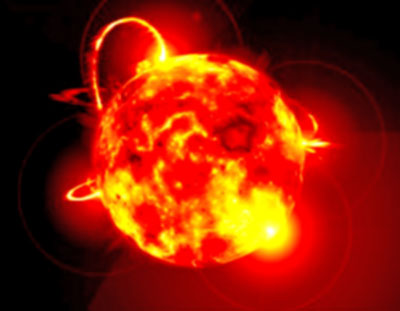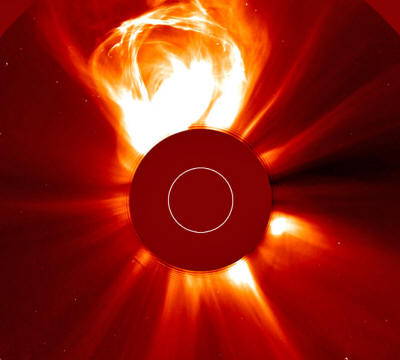|
from Helium Website
Some have predicted devastating solar tsunamis that could wipe away our advanced technology, others voiced dire warnings that violent explosions on the surface of the sun could reach out to Earth, breach our magnetic field, and expose billions to high intensity X-rays and other deadly forms of cancer-causing radiation.
Now evidence has surfaced that something potentially more dangerous is happening deep within the hidden core of our life-giving star:
Whatever it is, the evidence suggests it's affecting all matter.
Strange and unknown
Alarmed physicists first became aware of this threat over the past several years.
Initially dismissed as an anomaly, now frantic scientists are shooting e-mails back and forth to colleagues across the world attempting to grasp exactly what is happening to the sun.
Something impossible has happened. Yet the “impossible” has been proven to be true. Laboratories around the globe have confirmed that the rate of radioactive decay - once thought to be a constant and a bedrock of science - is no longer a constant. Something being emitted from the sun is interacting with matter in strange and unknown ways with the startling potential to dramatically change the nature of the very Earth itself.
Exactly what has scientists so on edge is the fact that the natural rate of decay of atomic particles has always been predictable. Indeed, using the decay rate of Carbon-14 has been a method to date archeological artifacts. The process, known as carbon dating, measures the quantity of Carbon-14 within organic objects.
According to the numbers, Carbon-14 has a specific half-life of 5,730 years.
Physicists have proven through exhaustive observation and experimentation over the course of a century that it takes 5,730 years for Carbon-14 atoms to decay into a stable Nitrogen-14.
The values don't change - or at least they never have in the past. With certain evidence that radioactive decay can be significantly affected by an unknown effect from the sun, much of science is turned on its head.
Rate of decay speeding up
Worst of all, if the decay rates of matter are being mutated then all matter on Earth is being affected including the matter that makes up life.
The mutation may go so far as to change the underlying reality of the quantum universe - and by extrapolation - the nature of life, the principles of physics, perhaps even the uniform flow of time. In fact, some evidence of time dilation has been gleaned from close observation of the decay rate.
If particles interacting with the matter are not the cause - and matter is being affected by a new force of nature-then time itself may be speeding up and there’s no way to stop it.
Neutrinos the cause?
Researchers have correlated the anomalies in the decay rate to a 33-day period.
That time frame matches the 33-day rotation of the solar core. Such a match strains credulity as being a mere coincidence. Since the sun's core is known to blast out continuous streams of particles called neutrinos, some scientists are attempting to find evidence that neutrinos are the culprits behind the mutation of matter.
There's a problem with that hypothesis, however, as neutrinos are like ghost particles. They're extremely difficult to detect. Normally, neutrinos pass through the Earth without any interaction at all. To a neutrino, it's as if the Earth doesn't exist.
Other than discovering a previously unknown property of neutrinos, or finding a new particle altogether, the possibility exists that no particle is behind the changes recorded in the radioactive decay rates.
What could be causing the phenomenon is a previously unknown force.
Unknown dangers
As the sun builds towards solar maximum and a period of dangerous intensity never experienced by any living person inexorably approaches, strange, uncontrollable forces could be building deep within its fiery nuclear furnace.
It's already been proven that the sun's mass,
Now this new force may be directly interacting with matter in a way that could not only change Mankind's understanding of physics, but change Mankind itself…and not necessarily in a beneficial way.
In the end, we are all just observers. Whether the phenomenon has no real impact on humanity, or the worst impact imaginable, nothing can be done to stop it.
Once again, the titanic forces of nature rear up to overwhelm our technology - and we find ourselves like the playthings of gods.
Additional information: see below reports...
Additional information
from NewsDiscovery Website
This is to be expected when pushing our
knowledge of the Universe to the limit.
But what if a well-known - and apparently constant - characteristic
of matter starts behaving mysteriously?
School textbooks teach us this from an early age.
This is the conclusion that researchers from Stanford and Purdue University have arrived at, but the only explanation they have is even weirder than the phenomenon itself:
Or, at the very least, we are seeing some new physics.
The event was captured by NASA satellites.
Many fields of science depend on measuring constant decay rates.
For
example, to accurately date ancient artifacts, archaeologists
measure the quantity of carbon-14 found inside organic samples at
dig sites. This is a
technique known as carbon dating.
If this new finding is proven to be correct, even if the
impact is small, it will throw the science community into a spin.
Decay
rates would slightly decrease during the summer and increase during
the winter.
But there's a huge problem with speculation that solar neutrinos could impact decay rates on Earth:
Neutrinos, born from the nuclear processes in the core of the sun, are ghostly particles.
They can literally pass through the Earth
unhindered as they so weakly interact. How could such a quantum
welterweight have any measurable impact on radioactive samples in
the lab? from News.Softpedia Website
He was a part of the group that
conducted the work.
The finding could have
significant implications.
It may very well be that the interaction between the Sun and radioactive materials is caused by a new, yet-undiscovered particle, physicists say.
from
PopSci Website
The big news, according to Stanford's news service, is that the core of the sun - where nuclear reactions produce neutrinos - spins more slowly than the surface.
This phenomenon might explain changing
rates of radioactive decay scientists observed at two separate labs.
But it does not explain why the decay-change happens. That violates
the laws of physics as we know them.
Apparently radioactivity is stronger in winter than in summer. A 2006 solar flare suggested the sun was involved somehow.
Purdue University nuclear engineer
Jere Jenkins noticed the decay rate of a medical isotope dropped
during the solar flare, and what's more, the decline started before
the flare did. The latter finding could be useful for protecting
satellites and astronauts - if there is a correlation between decay
rates and solar activity, changed decay rates could provide early
warning of an impending
solar storm.
Though disaster movies would have you
believe otherwise, we should not yet worry about solar neutrinos
warming the core of the Earth. But perhaps we should worry that our
understanding of the sun - and perhaps our understanding of nuclear
physics in general - is a lot weaker than we thought. 23 September 2010
from
News.ScienceMag Website
Now scientists have discovered that
powerful bursts of magnetism emanating from sunspots near the poles
of the sun can be arced back toward Earth by the solar magnetic
field. The finding creates another potential headache for people who
run or rely on GPS satellites, telecommunications networks, and
power grids, but it also means more reliable warnings about these
electromagnetic disturbances.
They can also overload electric power grids on the ground and pose a radiation hazard for astronauts in orbit.
One recent U.S. National Academy of Sciences study of the potential hazards from a major CME hitting Earth estimated that the damage could total more than a trillion dollars and require up to 10 years to repair.
Scientists have spent years attempting
to track CMEs and provide enough warning to allow precautions, such
as placing satellites in temporary safe modes.
Further analyses revealed, however, that the curving solar storm tracks were accurate.
CMEs emerging from sunspots located at latitudes of 60˚ or higher, north and south, can have their tracks bent by the sun's magnetic field and pushed out toward the planets by the 500-kilometer-per-second solar wind.
Gallagher and colleagues report this week in Nature Communications that the magnetic fields of CMEs also affect their trajectories.
These fields tend to rotate, and their
rotation can either sharpen the curve of the trajectory or flatten
it out, depending on whether the CME is traveling slower or faster
than the solar wind at the moment. The result is that, just like the
breaking curveballs by a Major League pitcher, the bent tracks of
CMEs can vary.
The normal reaction when CMEs emerge from the polar regions has been to think,
The new data show that isn't the case.
The ability to track even curving CMEs through space,
The researchers have,
Thompson adds that although scientists have long known solar storms can change directions while close to the sun,
|




